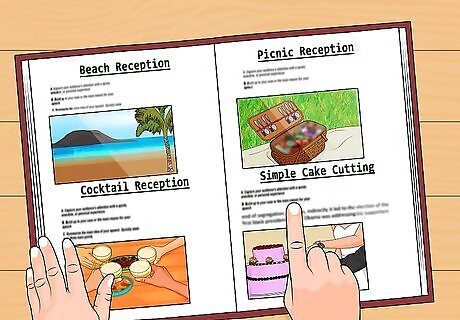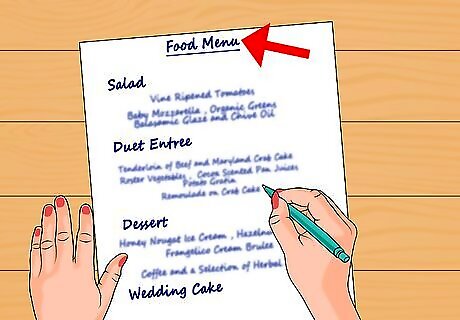
views
Deciding on key elements of a reception

Decide whether your event will be indoors, outdoors, or both. If you want an outdoor event, you'll have to consider the possibility of rain and have an indoor alternative. The season is crucial, particularly if you're on a tight budget. Planning your wedding reception in winter, at the end of January for instance, will save money or earn you a discount. In some cases, planning your wedding reception requires you choose between Saturday and Sunday as the most convenient days of the week. Usually, Sunday is less expensive.

Decide on the type of reception you'd like to have. Nowadays the two main types of reception are a buffet or a sit-down meal, but other variants such as picnics, a simple cake-cutting, or a beach reception might also appeal. Here are some things to consider in relation to different reception types: Buffet: Lots of food will be served, and people sometimes have a tendency to take too much food or there might be a lot of food left over. Sit-down: It's traditional, guests tend to really appreciate it and it works well for speeches. On the downside, it can feel stuffy and over-planned. It can also be the most expensive option. Cocktail reception: It's hip and modern, and it's also enjoyed a lot by guests. It may cost a lot less than a sit-down, but it can suffer from feeling a bit disorganized and hard to gain the attention of guests for cake cutting and toasts. Picnic: Great for nature-loving couples, and easy to arrange catering can be done using your local favorite sandwich place. Since it's outdoors, there can be a risk of rain and some people might find this too informal for a wedding. Simple cake cutting: For those leaving the registry office, a simple affair of cutting a cake in the foyer, or in a local cafe or even at home might be enough to finish up the occasion with friends who have attended it. This tends to be suitable for very small parties and for people who really didn't want to have any reception fuss at all. Have tea, coffee, and few cookies or cupcakes as well. Beach or yacht reception: Like a picnic, this is outdoors and risks a change of weather but it can be a lot of fun and make for beautiful photos. Again, it may be too informal for some and sand or water may definitely get everywhere!

Consider whether or not you'll have a receiving line. On the positive side, this can provide an opportunity to greet all guests and allows everyone to feel they've had the chance to congratulate you. On the downside, it can take a lot of time and it can begin to feel tiring for those on it. Some guests may also detest the formality of this and having to wait in line. Having divorced parents can also make this an awkward decision for some. If you do have one, this is the order: Bride's mother or parents, groom's mother or parents, bride, groom, maid of honor, then bridesmaids.

Consider whether you'd like to be announced as you enter the reception. This can be a lot of fun and can be done simply and easily by the DJ or bandleader, saying something like "Ladies and Gentlemen, please welcome the newlyweds Bob and Billie (or Mr and Mrs)", and you can then take your places for dinner.

Decide when to have the toasts and plan to keep them short. While these are both traditional and wonderful, they're a pain when they're too long, too maudlin, rude, or just plain dull. Make the toasts during or between dinner courses, with two or three people speaking each time. Ask all toasters to keep it short and have someone in the wedding party time keep - and be strict about it too. The bride and groom can speak just before cutting the cake.

Decide when dancing will occur. Nowadays, most weddings tend to leave the dancing until all courses are finished rather than having dances between courses. Besides your wedding song, be sure to have songs people will really want to dance to, especially since three or four generations may be attending the reception. Does the bride wish to dance with her father and does the groom wish to dance with his mother? You could have a father and daughter as well as a mother and son dance sessions.

Organize the photography of the reception. You will want reception photos as much as the ceremony photos. Organize pictures with family and friends, in special groups or at certain tables. Do you want guests to take photos too? They could each be asked to email digital photos of the evening that they've taken; give them a central wedding photo email set up just for this purpose.

Consider whether you wish to have any other ceremonial aspects. For example, you might wish to have the garter removal tradition in front of the guests. And you might wish to throw the bouquet at your reception, as per tradition.
Planning the food

Choose the food. There will always be some people with dietary restrictions, so be prepared to provide vegetarian, gluten-free, and other variants as needed. It's a good idea to have asked guests in advance for advice concerning allergies. A cocktail reception will usually on have nibbles and finger foods but still have both vegetarian and non-vegetarian options available. Decide how many courses you want for a sit-down dinner and be sure to check this against your budget. Sit-down dinners usually have menus printed up for them. Buffet style (help yourself) or serving at a table? There are also variants such as placing larger servings on the table for guests to help themselves from (family - or Russian service if the waiter holds the food), or plated (arrives at table already done), or French (waiters serve at the table), etc.

Choose where the wedding cake will be placed during the reception. Decide when it will be cut. Do you want guests to share the cake as part of dessert or to take a piece home instead? Perhaps both? Ensure that the photographer is organized to take a photo of you cutting the cake.




















Comments
0 comment